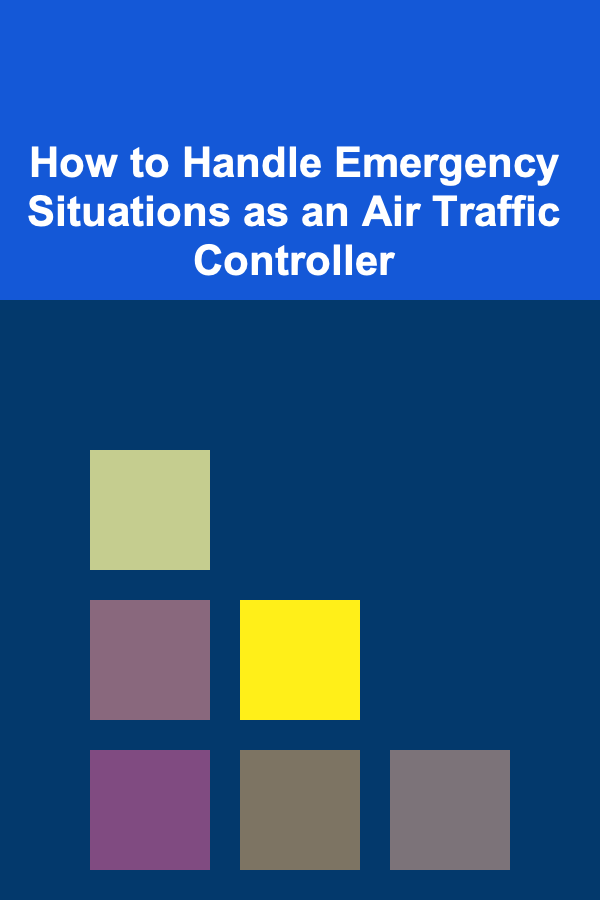
How to Handle Emergency Situations as an Air Traffic Controller
ebook include PDF & Audio bundle (Micro Guide)
$12.99$11.99
Limited Time Offer! Order within the next:

As an air traffic controller (ATC), the role is one of immense responsibility, requiring quick thinking, calm demeanor, and precise communication, especially in emergency situations. Air traffic controllers are at the center of ensuring the safety, efficiency, and orderly flow of air traffic. While they are trained to handle various everyday scenarios, emergency situations present unique challenges that demand immediate, professional responses to mitigate risk and ensure passenger safety.
In this article, we will explore the critical skills, strategies, and best practices that air traffic controllers need to handle emergency situations effectively. By the end of this guide, we will cover key emergency protocols, psychological resilience, teamwork, and the necessary technical know-how to manage unforeseen crises in air traffic control.
Understanding the Role of an Air Traffic Controller in Emergencies
Before diving into specific emergency protocols, it's important to establish what an air traffic controller's responsibilities are in a crisis. At its core, the job is about guiding aircraft safely through airspace and ensuring they avoid collisions. However, in an emergency situation, the stakes are much higher. Controllers are responsible for ensuring the safety of the crew, passengers, and others on the ground.
Key responsibilities of an ATC during emergencies include:
- Effective Communication: Controllers must maintain clear and concise communication with pilots, other air traffic controllers, and emergency services. Confusion or miscommunication could have disastrous consequences.
- Situational Awareness: ATCs need to maintain constant situational awareness, understanding the positions, altitudes, and conditions of all aircraft in their control zone. During an emergency, maintaining this awareness is crucial to decision-making.
- Decision-Making: Controllers are trained to make quick decisions, especially in stressful situations. In emergencies, their decisions can impact the lives of hundreds of people in the air and on the ground.
Types of Emergencies in Air Traffic Control
Air traffic controllers need to be prepared for a wide range of potential emergencies. While some are relatively routine, others can be catastrophic. Broadly, these emergencies can be classified into several types:
2.1. Aircraft Emergencies
Aircraft emergencies are the most common type of crisis an air traffic controller may face. They include:
- Mechanical Failures: Problems like engine failure, loss of power, or malfunctioning instruments may necessitate a diversion or emergency landing.
- Fuel Emergencies: Aircraft may find themselves in a fuel emergency due to miscalculations, delays, or changes in flight routes, requiring an immediate priority for landing.
- Medical Emergencies: A medical emergency on board may require the aircraft to land as soon as possible for medical treatment.
2.2. Weather-related Emergencies
Weather-related emergencies occur when adverse weather conditions impact the flight's safety. This can include:
- Severe Weather: Thunderstorms, turbulence, lightning, and high winds may affect the flight path, causing delays or diversions.
- Low Visibility: Fog, snow, or other visibility-reducing conditions may make navigation difficult, especially during takeoff or landing.
2.3. Air Traffic Collisions
Although rare due to stringent safety measures, the threat of mid-air collisions still exists. Controllers must be prepared to respond to near-miss scenarios or, in the worst case, collisions.
2.4. Airport-related Emergencies
Some emergencies may occur on the ground, but they are just as crucial for an air traffic controller to address quickly. These can include:
- Runway Incidents: Debris or a disabled aircraft on the runway can block incoming or outgoing traffic.
- Security Threats: Terrorist threats or hijack situations require the cooperation of ATCs, the military, and law enforcement.
Emergency Protocols and Best Practices
Each emergency situation is unique, but air traffic controllers generally follow established protocols. Familiarity with these protocols is critical to managing crises effectively.
3.1. Aircraft Emergencies Protocol
In the case of an aircraft emergency, the controller must:
- Listen Carefully to the Pilot's Request: Once an emergency is declared, the controller should give the pilot their full attention and acknowledge the emergency. It's vital to understand the nature of the emergency.
- Clear the Airspace: If an aircraft has a technical problem or fuel shortage, clearing airspace is crucial. Controllers must ensure that no other aircraft are in the way to allow for an emergency landing or diversion.
- Prioritize the Aircraft: Air traffic controllers must prioritize emergency aircraft over other traffic in the air. This means adjusting the routing of other flights and providing priority landing slots.
- Provide Continuous Support: Controllers need to maintain constant communication with the pilot, offering guidance and adjusting flight paths as needed.
- Alert Emergency Services: Notify emergency services, including fire, medical, and law enforcement, so they are ready for the aircraft's arrival.
3.2. Weather-related Emergencies Protocol
In cases of weather-related emergencies, controllers should:
- Monitor Weather Conditions: Regularly check weather updates and provide pilots with accurate, real-time information.
- Alter Routes if Necessary: If weather conditions are hazardous, controllers should reroute aircraft to avoid dangerous zones and guide them to the nearest safe airports.
- Implement Holding Patterns: If weather delays are significant, air traffic controllers may instruct aircraft to enter a holding pattern while waiting for better weather conditions.
- Provide Landing Assistance: In cases of low visibility, controllers should assist pilots in landing by providing detailed instructions and ensuring that the approach is clear.
3.3. Collisions and Near-miss Protocol
If a collision or near-miss occurs, controllers must act quickly:
- Issue Immediate Alerts: Immediately issue a "go-around" order or command evasive maneuvers to prevent a collision.
- Assess the Situation: Quickly determine if a collision has occurred and assess the need for emergency services.
- Follow Post-collision Procedures: After an accident, controllers must follow emergency response protocols, including notifying search-and-rescue teams and directing emergency landing efforts.
- Analyze and Report: After the emergency has been resolved, a thorough analysis is necessary to determine what led to the event and how similar incidents can be prevented in the future.
Psychological Resilience and Stress Management
Handling emergencies is an emotionally demanding job. The stress involved in air traffic control can be overwhelming, and maintaining mental clarity is essential to performing well in a crisis. Air traffic controllers must develop psychological resilience to handle stress effectively.
4.1. Stress Management Techniques
ATCs often deal with high-pressure situations, so adopting strategies to manage stress is critical:
- Breathing Exercises: Focused breathing can help calm nerves during stressful moments, enabling clearer thinking.
- Mindfulness: Practicing mindfulness can help controllers stay present, reducing anxiety during emergencies.
- Exercise and Sleep: Regular physical exercise and adequate sleep are crucial in maintaining long-term mental health.
4.2. Simulated Emergency Training
Regular training in simulated emergency scenarios is essential for preparing controllers to respond to crises. These drills help develop automatic, instinctive responses in high-pressure situations, ensuring that controllers are equipped to handle emergencies without hesitation.
Cooperation with Other Agencies
During emergencies, air traffic controllers often work in coordination with other agencies, such as:
- Fire and Rescue Services: To ensure that the aircraft can land safely and that the response to any fire or crash is swift.
- Medical Teams: In the event of a medical emergency, controllers need to coordinate with ground-based medical teams for timely assistance.
- Security Forces: In the case of hijackings or terrorist threats, the controller must work with military or police forces to address the situation.
Clear communication with these agencies is vital, as well as a coordinated response plan that minimizes confusion and speeds up the resolution of the crisis.
Technological Support in Emergencies
Modern technology plays a significant role in managing emergency situations in air traffic control. Tools like radar, automated conflict detection systems, and real-time weather updates allow air traffic controllers to assess situations more effectively. These technologies assist controllers in making quick, data-driven decisions and maintaining safety.
6.1. Automated Conflict Detection Systems
These systems help detect potential mid-air collisions or near-misses, providing controllers with alerts to take action before a dangerous situation develops. With these tools, controllers can focus on decision-making rather than manually tracking aircraft positions.
6.2. Advanced Weather Monitoring
Real-time weather monitoring tools allow controllers to receive immediate updates about severe weather conditions, enabling them to reroute aircraft and manage hazardous weather situations proactively.
Post-Emergency Debrief and Continuous Improvement
After any emergency situation is handled, it's important for air traffic controllers to participate in a debrief session. During these sessions, teams analyze the event, review how protocols were followed, and identify areas for improvement. This feedback loop is crucial for refining emergency procedures, ensuring that controllers can perform better in future emergencies.
Conclusion
Handling emergency situations is one of the most important and demanding aspects of an air traffic controller's job. The ability to manage stress, make quick decisions, and communicate effectively is essential in ensuring the safety of passengers and crew. By following established protocols, maintaining situational awareness, and continually honing their skills through training, controllers can effectively manage any emergency that arises. Their role is central to the safety of air travel, and their professionalism under pressure is key to preventing catastrophic outcomes.
Reading More From Our Other Websites
- [Personal Care Tips 101] How to Choose the Best Mascara for a Bold, Statement Look
- [Organization Tip 101] How to Use Folding Techniques for Space-Saving Storage
- [Personal Investment 101] How to Harness the Power of Compounding for Long-Term Wealth Growth
- [Personal Finance Management 101] How to Plan for Healthcare Costs in Your Budget
- [Home Cleaning 101] How to Clean a Carpet: Step-by-Step Guide for Deep Cleaning
- [Home Soundproofing 101] How to Seal Sound Leaks: Essential Tips for a Quiet Home Environment
- [Toy Making Tip 101] Sew-Crafted Kids' Classics: Reimagining Traditional Toys with a Sewing Machine
- [Sewing Tip 101] From Fabric to Fashion: A Step-by-Step Guide to Sewing Your First Outfit
- [Organization Tip 101] How to Manage Time Zones for International Classes
- [Metal Stamping Tip 101] How Automation is Transforming Metal Stamping Solutions Today

DIY Organic Gardening and Pest Control: Natural Solutions for a Thriving Garden
Read More
How to Handle Dietary Restrictions and Preferences for Food
Read More
How to Organize Your Home to Make the Most of Limited Space
Read More
How to Train Your Team to Use Automated Tools Efficiently
Read More
How To Observe Solar Eclipses Safely
Read More
How to Use a Crochet Planner to Manage Yarn Stash
Read MoreOther Products

DIY Organic Gardening and Pest Control: Natural Solutions for a Thriving Garden
Read More
How to Handle Dietary Restrictions and Preferences for Food
Read More
How to Organize Your Home to Make the Most of Limited Space
Read More
How to Train Your Team to Use Automated Tools Efficiently
Read More
How To Observe Solar Eclipses Safely
Read More